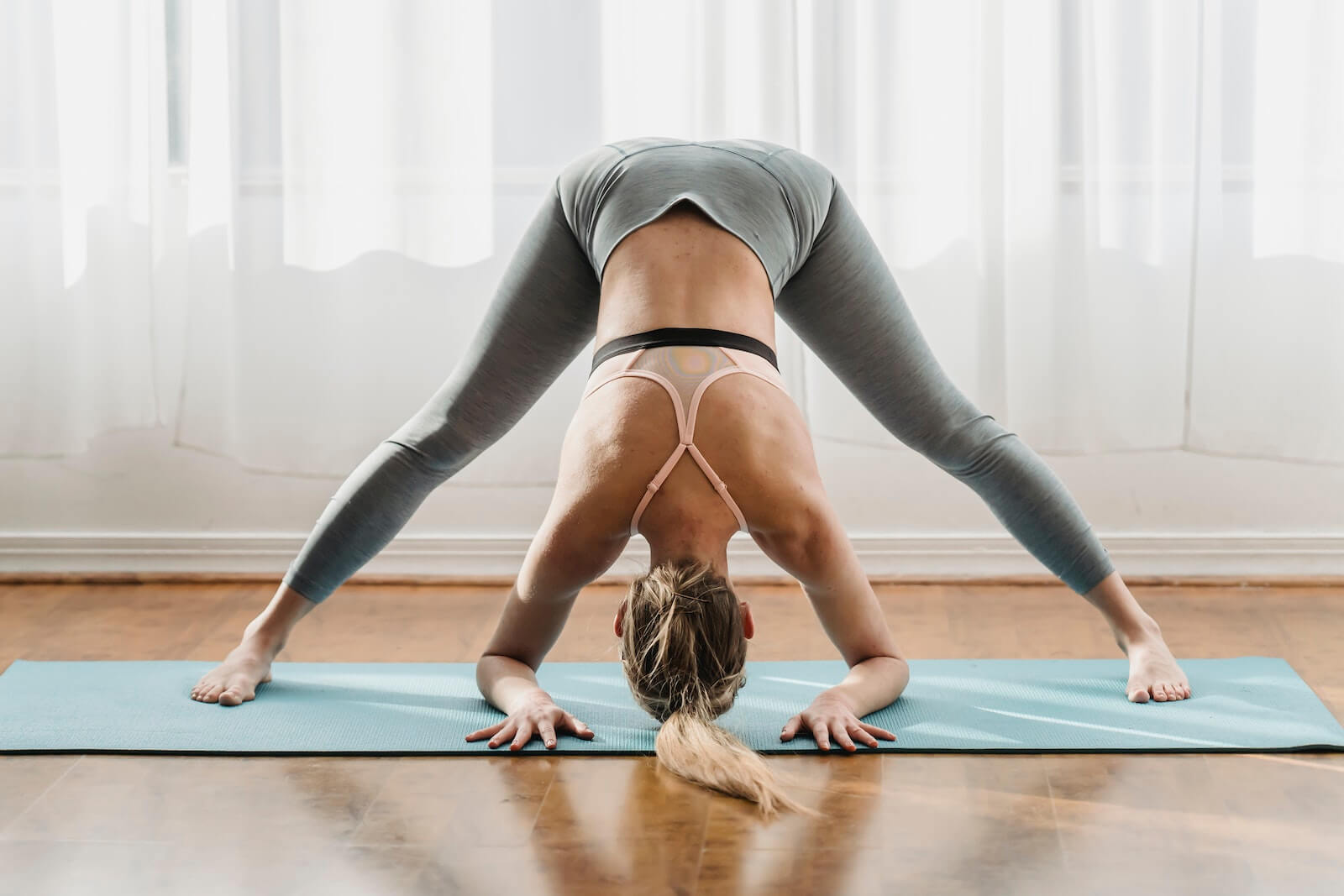If you’re just starting out with yoga and notice your hamstrings feeling tight, you’re not alone. Tight hamstrings are incredibly common, especially if you live a sedentary lifestyle. The good news is that a regular yoga practice can help improve hamstring flexibility and relieve discomfort.
Certain yoga poses are particularly beneficial for targeting tight hamstrings. When performed properly and consistently, these poses will gently lengthen the hamstrings while building strength. The result is better range of motion, less pain, and improved posture.
Keep reading to learn what tight hamstrings are, why it matters, the benefits of yoga, and 5 beginner-friendly yoga poses that will help you gain flexibility in your hamstrings.
What Are Tight Hamstrings and Why Does It Matter?
Your hamstrings are a group of three muscles located along the back of your thighs. They allow you to bend your knees, extend your hips, and stabilize your pelvis.
Tight hamstrings occur when these muscles lack flexibility. This causes a shortening of the muscle fibers and a decrease in range of motion.
Symptoms of tight hamstrings include:
- Feeling a pull or strain in the back of your thighs when bending forward, stretching, or reaching for your toes
- Discomfort or pain in your lower back
- Poor posture and rounded shoulders caused by your pelvis tilting forward
- Reduced mobility in your hips and knees
- Muscle cramps and increased risk of strains or tears
Limited flexibility in your hamstrings can make everyday activities like bending over to tie your shoes challenging. It also prevents you from performing certain exercises and poses with proper form.
Furthermore, tight hamstrings are linked to low back pain. When your hamstrings are tight, your pelvis is pulled out of alignment. This puts more stress on the lumbar spine and can lead to pain and stiffness.
Improving flexibility in your hamstrings through yoga can help reduce back pain and discomfort. It also allows you to move through your full range of motion with ease.
The Benefits of Yoga for Tight Hamstrings
Yoga is an excellent way to address tight hamstrings for several reasons:
Gentle stretching – Yoga poses like forward folds target the hamstrings with gentle, relaxing stretches instead of aggressive straining. This protects against injury.
Increased range of motion – A regular yoga practice lengthens and strengthens the hamstring muscles, improving flexibility. This makes daily movements like bending and walking more comfortable.
Pain relief – Yoga can alleviate tight hamstring discomfort and lower back pain by releasing tension and tightness.
Mind-body connection – Yoga helps you tune into your body so you can identify problem areas. This awareness prevents overstretching.
Holistic approach – In addition to physical benefits, yoga reduces stress and instills mindfulness. This holistic approach supports overall wellbeing.
Low impact – The gentle nature of yoga poses is ideal for beginners and those with limited mobility, since there is no strain on the joints.
Accessibility – Yoga requires minimal equipment and can be practiced anywhere. Poses can be modified to accommodate different abilities.
A well-rounded yoga practice that focuses on hip and hamstring flexibility will open up the back of your thighs safely and effectively. Always listen to your body, avoid pain, and ease into deeper stretches over time.
Now let’s get into 5 of the best yoga poses for beginners with tight hamstrings. Try practicing these postures 2-3 times per week to see real improvements in flexibility.
1. Downward-Facing Dog (Adho Mukha Svanasana)
Downward-facing dog is an inversion pose that stretches the entire backside of your body. It’s one of the most widely recognized and utilized yoga poses for its hamstring lengthening benefits.
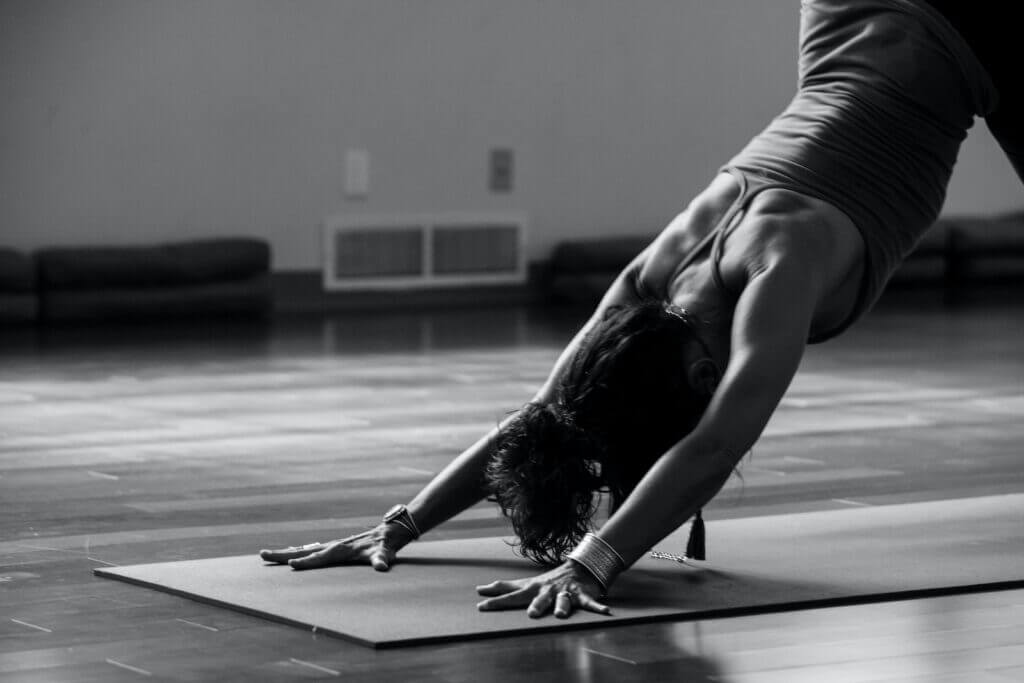
To come into downward facing dog:
- Start on your hands and knees with wrists under shoulders and knees under hips.
- Curl your toes under and straighten your legs while lifting your hips up and back to form an inverted V shape.
- Ground down through your palms, rotate your elbows forward, and lengthen your spine.
- Allow your head to hang naturally as you press your chest back toward your thighs.
- Engage your core and quadriceps, then push your sitting bones up toward the ceiling.
- Hold for 30-60 seconds, breathing deeply.
Keep your hamstrings engaged in this pose. If needed, gently bend your knees to release tension. The pull on the back of your legs combined with the inverted nature of this pose is extremely therapeutic.
Benefits: Stretches hamstrings, calves, and shoulders while strengthening arms, legs, and core. Calms the mind.
2. Standing Forward Bend (Uttanasana)
Standing forward bend may seem simple, but it offers an excellent stretch all through your posterior chain. It specifically targets tight hamstrings. Use a chair or block to provide support if needed.
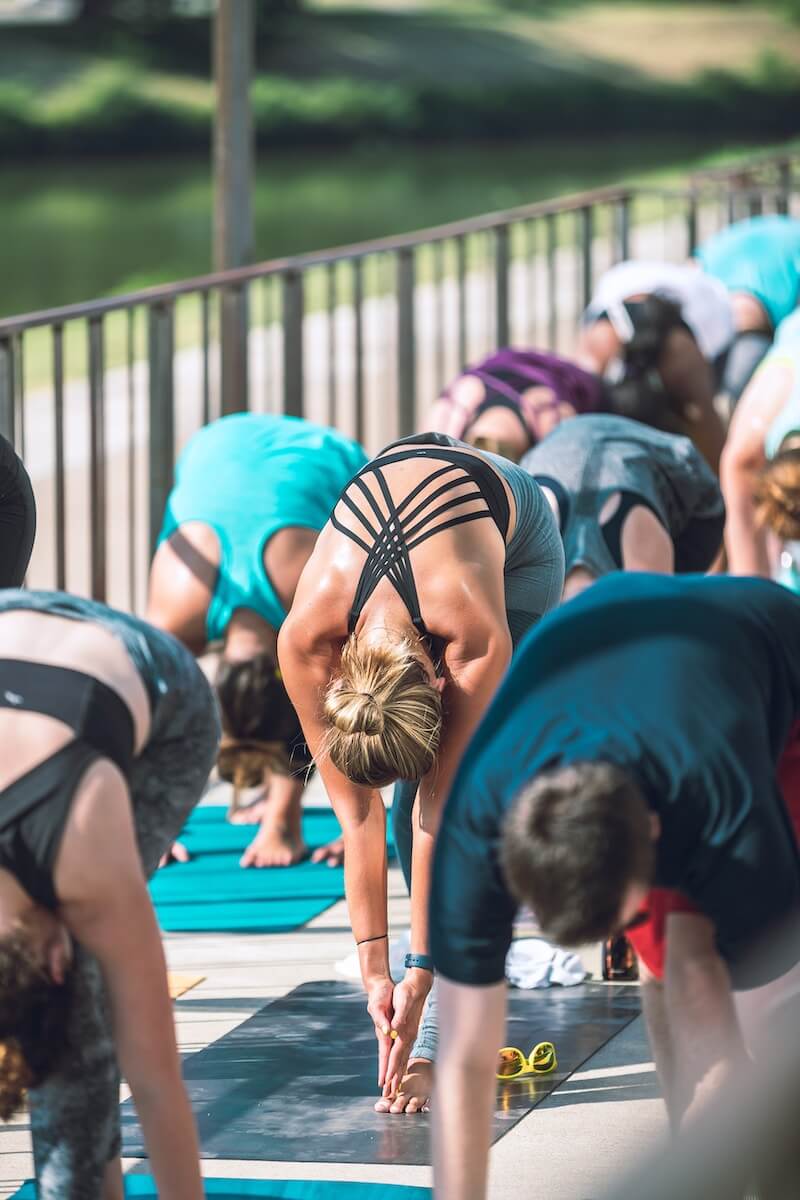
Here is how to properly do standing forward bend:
- Stand with your feet hip-width apart. Engage your core.
- Inhale and raise your arms overhead with palms facing each other.
- Exhale and hinge forward at the hips, keeping your back flat. Lower your torso toward the ground.
- Release your hands and let your head hang freely. Allow gravity to pull you deeper into the stretch.
- Hold for 30-60 seconds. Place your hands on blocks or a chair if needed.
- To exit, engage your core and slowly rise back up to standing, one vertebra at a time.
Only go as far as feels comfortable. Keep knees slightly bent to avoid overstretching your hamstrings. This pose lengthens your entire back body.
Benefits: Stretches hamstrings, calves, shoulders, and spine. Improves posture. Relieves stress.
3. Wide-Legged Forward Bend (Prasarita Padottanasana)
The wide stance of this pose allows you to target your inner and outer hamstrings for a deeper stretch. Use blocks or a chair for support as needed.
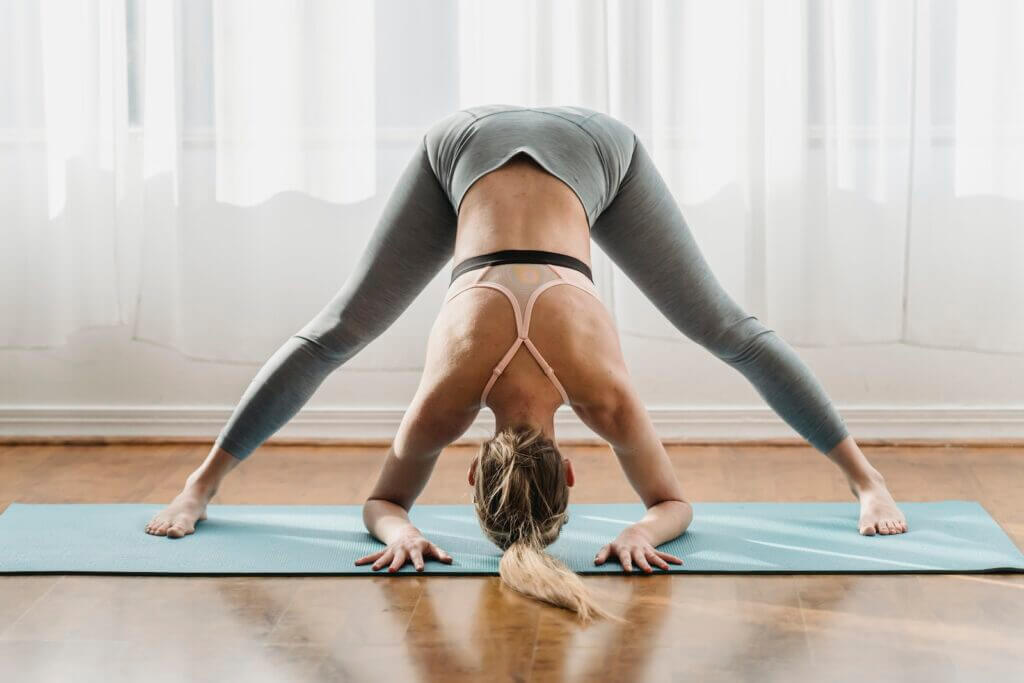
To practice wide-legged forward bend:
- Stand with your feet 3-4 feet apart. Turn your toes slightly inward and engage your thighs.
- Inhale and extend your arms out to the sides, parallel to the ground with your palms down.
- Exhale and hinge forward from your hips, lowering your torso toward the floor.
- Release your hands and relax your head and neck. Hold for 30-60 seconds.
- Place your palms on the ground or blocks. Keep your core engaged.
- Inhale and lift your torso halfway up. Exhale to release back down again. Repeat 5-10 times, flowing with your breath.
- Carefully return back to standing, engaging your core and rising one vertebra at a time.
The wide stance stretches your inner thighs and hamstrings simultaneously for increased flexibility. Modify by bending your knees or using blocks as needed.
Benefits: Stretches inner thighs, hamstrings, calves, shoulders, and spine. Improves balance and posture.
4. Seated Forward Bend (Paschimottanasana)
This seated pose provides an intense but safe hamstring stretch. Use a strap around your feet if you cannot reach them with your hands.
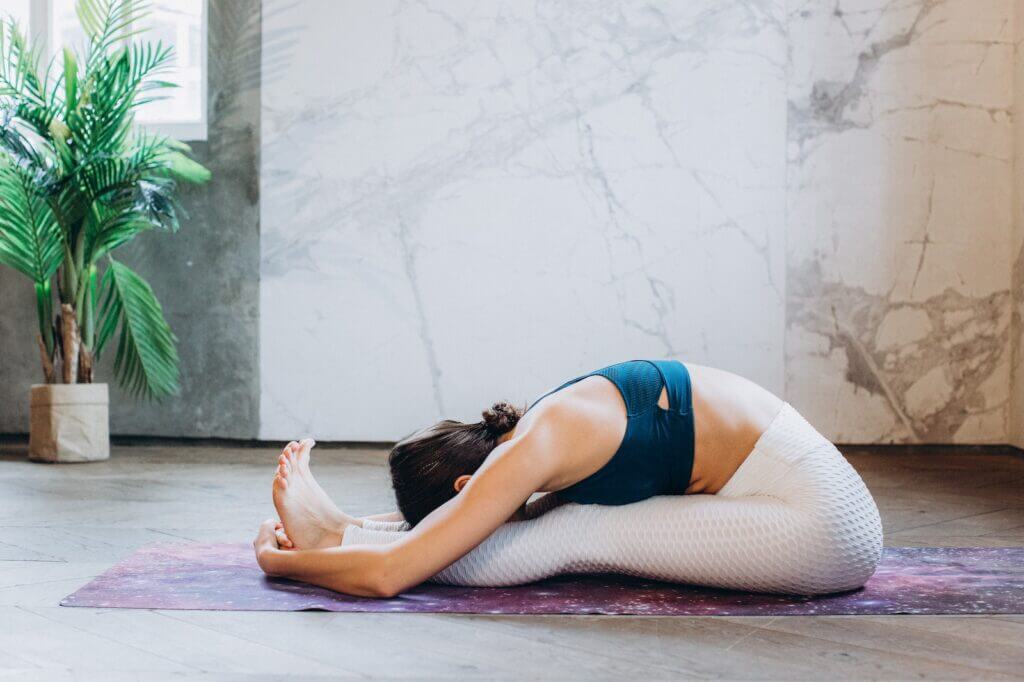
Follow these steps for seated forward bend:
- Sit on the floor with legs extended straight in front of you. Press your thighs down and flex your feet.
- Inhale, lift your chest, and reach your arms upward with palms facing each other.
- Exhale and hinge forward from your hips, reaching for your toes. Keep your spine long.
- Clasp your big toes with your first and second fingers. If you can’t reach them, loop a strap around your feet.
- Continue folding deeper on each exhale, maintaining length in your spine. Avoid rounding your back.
- Hold for 30-60 seconds, breathing deeply in and out through your nose.
- Rise back up with control on an inhale, engaging your core. Repeat 2-3 times.
This seated stretch safely lengthens your hamstrings when done with proper alignment. Build flexibility gradually over time.
Benefits: Deeply stretches hamstrings, lower back, and calves. Improves posture. Calms the mind.
5. Reclining Big Toe Pose (Supta Padangusthasana)
This gentle supine hamstring stretch is a great option for beginners. Use a strap around your foot if needed.
Here are instructions for reclining big toe pose:
- Lie on your back and press your low back down toward the floor. Extend your right leg along the ground.
- Bend your left knee into your chest. Inhale and straighten your left leg upward toward the ceiling.
- Exhale and fold your leg over your body toward your right hand. If you can’t reach it, place a strap around the sole of your foot.
- Flex your foot to lengthen your leg behind you. Gently pull the strap to sink into the stretch, but avoid pain.
- Hold for 30-60 seconds, then repeat on the other side. Breathe deeply.
The supine position makes this stretch accessible. Pull your leg back slowly and gently until you feel the hamstring engage.
Benefits: Stretches hamstrings, lower back, and calves. Improves flexibility. Relieves sciatica.
Beginner’s Tips for Practicing Yoga With Tight Hamstrings
It’s normal for yoga to feel challenging at first if you have tight hamstrings and muscles. Here are some tips for beginners:
- Warm up before stretching with simple movements like walking or marching in place.
- Move slowly and gently. Never force your body into a pose.
- Use props like blocks, straps, and blankets to help you stretch safely and comfortably.
- Avoid pain. Back off if a stretch doesn’t feel good.
- Focus on alignment and proper technique, not how deep the pose looks.
- Engage your core during poses to protect your lower back.
- Start with shorter hold times of 10-30 seconds and gradually increase.
- Balance stretching with strengthening poses to build hamstring flexibility.
- Rest when needed between poses and don’t overdo it.
Be patient and compassionate with your body as you cultivate flexibility over time through yoga. Consistency is key for reducing tight hamstrings.
Conclusion: Get Started With Yoga to Loosen Your Tight Hamstrings
If your hamstrings tend to feel uncomfortably tight, incorporating yoga into your routine can help provide relief. Certain yoga poses gently stretch and lengthen the hamstrings for improved flexibility and mobility.
When done regularly, yoga increases your range of motion, eases soreness, enhances posture, and reduces your risk of lower back pain. Make sure to listen to your body, move mindfully, and use props as needed.
As a beginner, start slow with foundational poses like downward dog, standing forward bend, and reclining big toe pose. Over time, your hamstrings will loosen up, allowing you to advance to more challenging postures.
Don’t get discouraged if progress feels slow. Building flexibility takes dedication and patience. Even doing just 10 minutes of targeted hamstring stretches several times a week can make a difference.
Now you have 5 beginner-friendly yoga poses to help address tight hamstrings. Incorporate these into your wellness routine to feel better in your body and prevent pain and immobility. With consistency, you’ll start lengthening those hamstrings and experiencing the many benefits of yoga.

